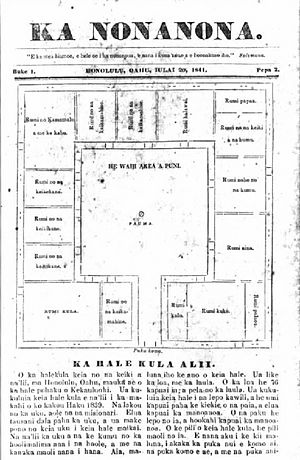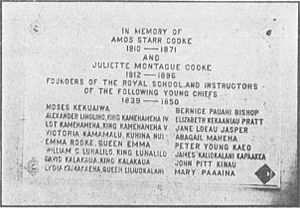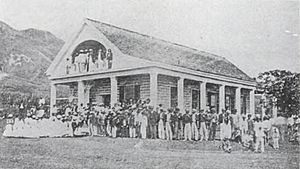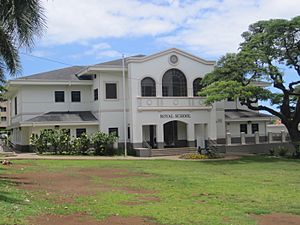Royal School (Hawaii) facts for kids
Quick facts for kids Royal School |
|
|---|---|
| Address | |
|
1519 Queen Emma Street
, |
|
| Information | |
| Former name | Chiefs' Children's School (1839-1846) |
| Established | 1839 |
| Grades | K-5 |
The Royal School is a very old school in Honolulu, Hawai'i. It started in 1839 as the Chiefs' Children's School. This school was created to teach the children of Hawaiian royalty. In 1846, its name changed to the Royal School.
Later, in 1850, it stopped being a boarding school. It became a day school for all children. Over time, it grew into a public elementary school. The school moved to its current location in 1967. Today, it is known as Royal Elementary School. It teaches students from kindergarten to Grade 5. The school has won awards, like being named a Blue Ribbon School many times.
Contents
History of the Royal School
How the School Started
King Kamehameha III of the Kingdom of Hawaii founded the Chiefs' Children's School. He wanted to educate the children of the Hawaiian royal families, known as aliʻi. The school was a boarding school, meaning students lived there.
The first school building was where the ʻIolani Barracks are now. Leaders decided to create the school in June 1839. The buildings were ready by 1840. More students joined the school in 1842.
Who Attended the School
An article from 1844 listed the students. It said they were "princes and chiefs eligible to rulers." This means they were future leaders of Hawaii. The main goal was to prepare them to govern the kingdom.
Most students came from seven royal families. These families were close relatives of King Kamehameha III. They were also Christian. Here are some of the important students:
- From Kamehameha III's sister, Kīnaʻu: Lot, Victoria Kamāmalu, Moses Kekuaiwa, and Alexander Liholiho.
- From his half-brother, Pauli Kaʻōleiokū's family: Bernice Pauahi and John William Pitt Kīnaʻu.
- From his father's younger brother, Keliʻimaikaʻi: Emma Naʻea and Peter Young Kaʻeo.
- From his father's younger brother, Kalaimamahu: William Charles Lunalilo.
- From his father's eldest brother, Kalokuokamaile: Elizabeth Kekaʻaniau Laʻanui.
- From his grandfather's cousin, Kameʻeiamoku's family: David Kalākaua, Lydia Kamakaeha, and James Kaliokalani.
- Also from his grandfather's cousin, Kahekili: Jane Loeau and Abigail Maheha.
Teachers and Daily Life
Amos Starr Cooke and Juliette Montague Cooke ran the school. They were missionaries from the American Board of Commissioners for Foreign Missions. The school building was a long, two-story wooden house. It had a big dining room. The children and the Cooke family had separate sleeping areas.
The school also had a New England style parlor. It was furnished with items from home and China. The school looked and felt very American. The royal children learned to speak and act like Americans. John Papa ʻĪʻī, a Hawaiian kahu (traditional caretaker), helped teach the students.
Changes to the School
In 1846, the Hawaiian government took over funding the school. Richard Armstrong, the Minister of Public Instruction, was in charge. The school was then renamed the "Royal School."
By 1848, fewer students attended. Many had graduated or gotten married. For example, Moses left school in 1847. He later passed away in 1848 during a measles outbreak. In 1849, children of missionaries were also allowed to attend.
The school moved to its current location in 1850. It changed from a boarding school to a day school for the public. Edward Griffin Beckwith became the next principal. He led the school until 1854. By 1853, the school had 121 students. Eight of them were full Hawaiian, and 18 were part Hawaiian.
Royal Elementary School Today
Today, the Royal School is a public elementary school. It is called Royal Elementary School. It is the oldest school on the island of Oʻahu. The school teaches students from kindergarten to Grade 5. It is located at 1519 Queen Emma Street.
In 2005, a sculpture by Kim Duffett was added to the school. It is called "Mai ka Hina Kua a ka Hina Alo." A foundation named after the Cooke Family helped pay for it.
Famous Alumni
Many important people attended the Royal School. Some became rulers of Hawaii. Others were important members of the royal family.
Ruling Alumni
- Queen Liliuokalani
- Queen Emma, wife of Kamehameha IV
- King David Kalākaua
- King Kamehameha IV
- King Kamehameha V
- Princess Victoria Kamāmalu, who was a high chiefess
- King William Charles Lunalilo
Royal Family Alumni
- Aliʻi Bernice Pauahi Bishop
- Aliʻi Abigail Maheha
- Aliʻi Mary Polly Paʻaʻāina
- Aliʻi Peter Young Kaʻeo
- Aliʻi Elizabeth Kekaʻaniau Pratt
- Prince Moses Kekūāiwa
- Prince John William Pitt Kīnaʻu
- Ali'i James Kaliokalani
Royal Alumni from Day School Era
- Gideon Kailipalaki Laanui
- Nancy Sumner
- Jane Swinton
- Martha Swinton
- Julia Moemalie
- Mary Ann Kiliwehi
- John Mahiʻai Kāneakua





